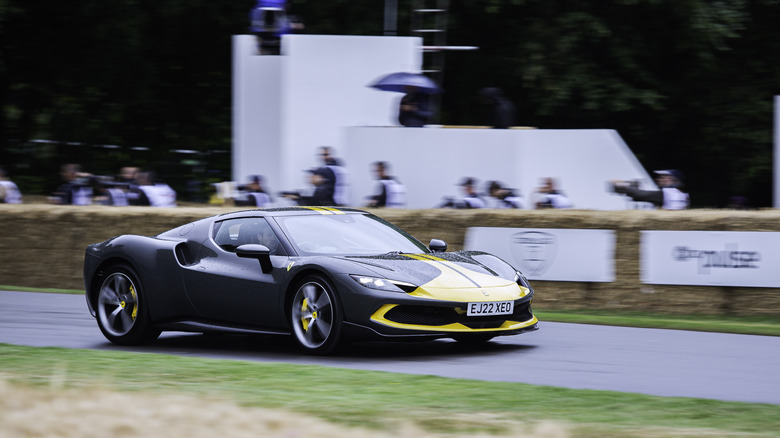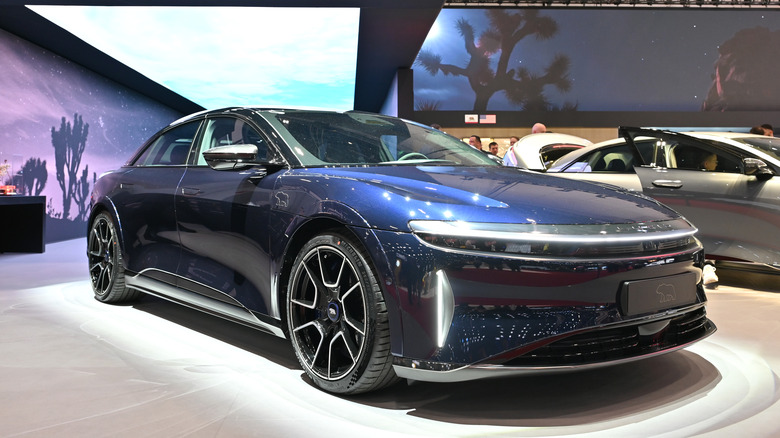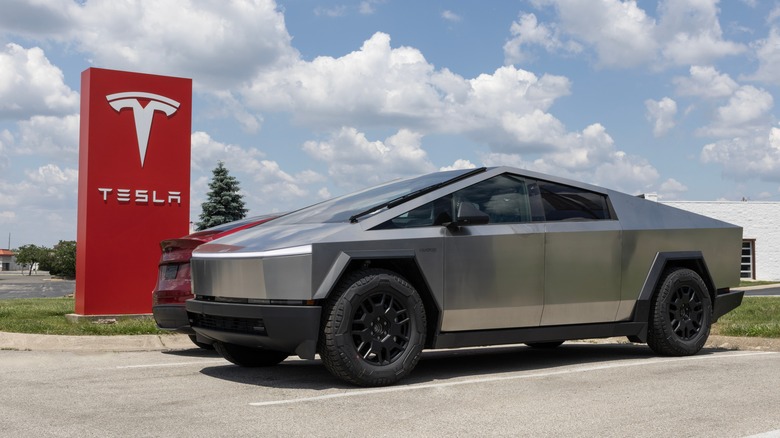
Martyn Lucy/Getty Images
Lots of trends could be symbolic of the automotive industry in the 2020s. Maybe your mind goes to the mass electrification movement, or the way the entire industry quickly backed away from it when it became clear people weren’t buying enough electric cars. Maybe you think of the all the screens that have covered an ever-growing share of new cars’ interiors. These aspects of modern car design (and many more) continue to be the butt of a lot of jokes and the subject of a lot of criticism.
Advertisement
However, there’s one other part of the car world in the 2020s that doesn’t get talked about enough: the horsepower war. Everyone has been scrambling to squeeze ridiculous, unnecessary horsepower outputs from cars that don’t need it, seemingly just for bragging rights.
This has been going on for quite some time, but it’s now reaching new levels of ridiculousness. If you ask me, none of these cars need the heinous amounts of power their powertrains produce, regardless of the bragging power that those outputs come with. Let’s have a look at some of the biggest offenders…
Mercedes AMG GT 63 E Performance — 805 hp
The Mercedes-AMG GT recently entered its second generation, sharing its platform with the latest SL-Class. It has an attractive exterior, a twin-turbo V8 under the hood (surprisingly), and a huge central infotainment setup. The GT 63 offers up 577 hp from said V8, and the new GT 63 Pro bumps that up to 612 hp. That’s plenty either way, but someone from the engineering team apparently thought «we need more.» Enter the GT 63 E Performance, a mouthful of a name for what can only be described as a handful of a car.
Advertisement
The E Performance retains the same twin-turbo V8, but also adds an electric motor and what Mercedes claims is a battery derived from F1 tech at the rear axle. The total output comes to a ridiculous 805 hp.
That makes it more powerful than the AMG-powered Pagani Huayra, an ultra-limited and ultra-exclusive supercar. With a claimed 0-60 time of 2.7 seconds, it’s also faster to 60 mph than the Mercedes-AMG One. You know, the ultra-limited hypercar with a powertrain pinched directly from an F1 car? That One. Aside from the fact that this type of power is strictly unnecessary in such a vehicle, those aforementioned hypercars kinda lose their specialness. What good is exclusivity and engineering achievements if they can be beat by a car that, technically speaking, anyone can go out and buy?
Advertisement
Lamborghini Urus SE — 789 hp
To exactly no one’s surprise, Lamborghini’s first SUV took the world of the rich by storm. After just a couple of years on the market, the Urus matched and bested the Gallardo’s entire decade-long production run. Even more proof that an SUV is the easiest way to get some cash flowing to your name if you’re an automaker.
Advertisement
As the badge on the front would indicate, the Urus is an SUV done the Lambo way. The regular Urus put out 641 hp from a twin-turbo V8, giving it a 0-60 time in the mid 3-second range and a top speed of over 190 mph. Sadly, the regular Urus has gone out of production, and the only way to have one now is with a plug.
The recently revealed Lamborghini Urus SE retains the same V8 with little to no changes, but it adds a hybrid component. The electric motor is mounted on the rear axle, and the total system output is a ridiculous 789 hp. That means the Urus SE is more powerful than every single version of the Aventador released throughout its decade-long production run. Aside from the previously mentioned talk of the supercar losing its specialty as a result, the previous Urus was perfectly fine and capable with 641 hp.
Advertisement
Mercedes-AMG A45 S — 409 hp
Hot hatchbacks are great. They give you everything you love about the regular hatchback model with extra power, extra noise, and extra fun. Super hatchbacks often add AWD and stupendous amounts of power that could make a sports car blush on top of all that. But when does a hatchback have too much power for its own good?
Advertisement
That would be the Mercedes-AMG A45 S. When the current generation of the hottest A-Class first appeared, Mercedes proudly claimed that under the hood lay the most powerful production four-cylinder engine in history — a 2.0-liter turbocharged I4 with 409 hp, to be precise.
Yes, 409 hp in a car the same size as a VW Golf or a Ford Focus. This hot hatchback has more power than the AJ V8-powered Aston Martin V8 Vantage, and more power than a 997 Porsche Carrera S. It’s more powerful than the current base 992 Carrera, too. Combined with AWD and a comparatively low weight figure, the A45 S can do 60 mph in less than 4 seconds. Wind the clock back 15 or 20 years, and a time like that was SLR McLaren and Carrera GT territory.
Advertisement
Don’t get me wrong, the horsepower figure that the A45 S musters up is very impressive, but also entirely unnecessary. It’s just a hatchback. You’re better off with a used Focus RS or Golf R. If it has to have a three-pointed star on the front, just get the A35.
BMW XM Label Red — 748 hp
Where do I even start with this one? It was a red flag right off the bat that only the second ever dedicated, bespoke BMW M model would be… a plug-in hybrid SUV. A plug-in hybrid SUV that looks like what the villain from a cyberpunk novel would use to get around and do shady business. In a bad way.
Advertisement
The heinously overstyled BMW XM is exclusively available with plug-in hybrid power, and the cream of the crop is the Label Red. I’m not entirely sure why those words are in the wrong order, but that’s the least of our worries here. The Label Red uses an upgraded version of the 4.4-liter twin-turbo V8 and electric motor for a total output of 748 hp.
748 hp is a lot for any car, but it’s really a lot for an SUV with the aerodynamic properties of a closet and one that weighs 6,063 pounds. While I’m fully aware that there is a market out there for atrocities like this, I think that most enthusiasts are bitter that BMW didn’t leverage the M division’s second chance to make a dedicated car for something more… exciting. I’ll take the XM that has a Citroen badge on the other side of the decklid, thank you.
Advertisement
Ferrari 296 GTB — 819 hp
After the last Dino 246, easily one of Ferrari’s best-looking cars, left the production line in the mid ’70s, the Italian automaker would take another five decades to reintroduce a V6-powered car to its lineup. The 296 GTB is the de facto replacement for the F8 Tributo, and as well as introducing an all-new bespoke V6 engine, it’s the second model in Ferrari’s regular lineup to be a plug-in hybrid.
Advertisement
The brand new 2.9-liter twin-turbo V6 has a 120-degree cylinder angle, and it nestles the turbochargers in the V of the engine, very similar to the McLaren Artura. The V6 on its own puts out a more than adequate 654 hp, but that wasn’t quite enough for Modena. The electric motor puts out 165 hp, bringing the total output to a ridiculous 819 hp.
What does that mean? Apart from the fact that the 296 GTB is massively more powerful than the McLaren Artura despite the two being competitors and sharing an almost identical powertrain setup, the power output is ridiculous for another reason. The 296 GTB is supposed to be Ferrari’s entry-level mid-engine supercar, yet it’s more powerful than the Enzo, most of the 599 lineup, the F12berlinetta, and it’s actually more powerful than the LaFerrari if you take away that car’s hybrid component. Despite its market positioning, the 296 GTB has an unfair advantage over most of its competitors currently.
Advertisement
Volvo EX30 Performance — 422 hp
Volvo is still very much embracing a fully electric future, as it continues to introduce new electric models to eventually usurp their ICE-powered equivalents in the lineup. The EX30 is the automaker’s entry-level EV, and also the smallest model that it currently offers. It’s absolutely tiny compared to other Volvo models, being much closer in size to the lovely C30.
Advertisement
As with a lot of other EVs, the EX30 is also available in a Performance dual motor variant. The motor-on-each-axle setup puts out 422 hp, which is almost comical for a car that’s the size of most sneakers. It may not the most powerful Volvo of all time, but with a claimed 0-60 time of 3.4 seconds, the EX30 is the fastest accelerating car the automaker’s ever made.
For one thing, a small crossover simply doesn’t need 400 or even 300 hp, as there’s an inherent clash between the target buyers of small electric crossovers and the target buyers of cars with power figures like this. What’s more, it feels like wasted potential that the fastest accelerating Volvo of all time is just a small electric crossover. It should have had five cylinders as far as I’m concerned, but it’s a bit too late for that.
Advertisement
MG 4 XPower — 429 hp
Believe it or not, Volvo is not the only automaker guilty of giving an obscene amount of power to a small electric car. Over in China, SAIC’s MG Motor has done something pretty much identical, but there’s one way we could let it slide. The MG 4 XPower brings back the badge last seen on that bizarre sports car with a Mustang engine and Fiat Punto headlights. Not to mention, MG is marketing the 4 XPower as a hot hatchback, so there is some justification for its high power output.
Advertisement
Even then, the XPower’s 429 hp is a bit excessive, especially considering that the normal MG 4 is perfectly fine with 204 hp and RWD. The MG 4 XPower’s 429 hp gives it a 0-60 time of less than 4 seconds, which is very impressive and will likely get the heart racing more than a few times. Not only is the power unnecessary, however, but MG committed the ultimate hot hatchback sin: It’s just not actually all that fun to drive.
One of the only incentives to actually buy a hot hatchback, electric or otherwise, is to have some serious fun in the corners. The XPower is decent, but does nothing that the regular MG 4 can’t do. Save your money and buy the regular RWD MG 4.
Lucid Air Sapphire — 1,234 hp

John Keeble/Getty Images
Do you want your electric luxury sedan to be more powerful than the original Bugatti Veyron, the SSC Ultimate Aero, or even the new Lamborghini Revuelto? The Lucid Air Sapphire could be right up your alley. Despite all the odds stacked against it, the Lucid Air has proven consistently that, when it comes to electric limos, your money shouldn’t always go to the owner of Twitter.
Advertisement
Some of the best EV range on the market comes together with stunning looks and some genuine luxury chops. But what does the Sapphire bring? 1,234 hp and a reworked chassis that’s properly ready for track driving. 1,234 hp and a 0-60 time of less than 2 seconds(!) is still excessive, but the Air Sapphire has something else going for it: insane handling, and despite the extra grunt, still great range.
All of that extra work to make it such a competent machine also added quite a lot to the price. The Sapphire retails at $250,000. It costs more than double what you’ll pay for a Tesla Model S Plaid, but if our first drive of the Lucid Air Sapphire is anything to go on, it’s more than double the car. Still, chopping a few horses off wouldn’t exactly make it any less of a car.
Advertisement
Tesla Cybertruck — 845 hp

Jonathan Weiss/Shutterstock
Broken promises, embarrassing reveal events, and one of the most troubled and ridiculed automotive launches in recent history. The Tesla Cybertruck is a pretty enigmatic vehicle. The fact that Tesla managed to get the Cybertruck out after an almost five-year delay is admirable, but nobody would use «problem-free» to describe its release.
Advertisement
Let’s address the power situation first. The top-of-the-line Cybertruck is called the Cyberbeast, and it puts out a colossal 845 hp. While that’s very impressive, and it allows the Cybertruck to reach 60 mph in the mid 2-second(!) range, nobody who’s in the market for a pickup truck wants to know whether or not their truck really can out-accelerate a Porsche 918. Well, the Cybertruck buyers specifically might, but that’s beside the point.
As well as the Cybertruck’s unnecessary amount of power that is pretty much of no use to a pickup truck, since, you know, that’s not what they’re about, it’s also just a bad product. Stuck throttle pedals, windows that sob at the sight of hail, faulty steer-by-wire that renders it undrivable, and of course, a stainless steel body that… stains quite easily. Just get an F-150 Lightning if you really want an electric truck.
Advertisement